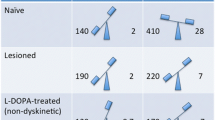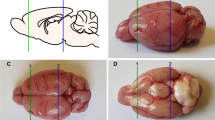Abstract
Metoclopramide antagonises apomorphine-in-duced stereotypy in rats (ED50 1.5 mg/kg), apomorphine reversal of reserpine-induced locomotor suppression in mice (50% inhibition produced by 17 mg/kg), and apomorphineor amphetamine-induced turning behaviour in mice with unilateral lesions of the striatal dopaminergic nerve terminals (ED50 5.0 and 4.0 mg/kg respectively). Metoclopramide resembles pimozide in all these respects and appears to be a relatively potent antagonist of striatal dopamine receptors. Yet metoclopramide, in anti-emetic doses, has no effect on disability in Parkinson's disease or on the therapeutic benefit of l-Dopa and l-Dopa dyskinesias.
Similar content being viewed by others
References
Andén, N.-E., Butcher, S. G., Corrodi, H., Fuxe, K., Ungerstedt, U.: Receptor activity and turnover of dopamine and noradrenaline after neuroleptics. Europ. J. Pharmacol. 11, 303–314 (1970)
Andén, N.-E., Strömbom, U., Svensson, T. H.: Dopamine and noradrenaline receptor stimulation: Reversal of reserpine-induced suppression of motor activity. Psychopharmacologia (Berl.) 29, 289–298 (1973)
Armitage, P.: Statistical methods in medical research, p. 249. New York: Wiley 1971
Borenstein, P., Bles, G.: Effets cliniques et électroencéphalographiques du métoclopramide en psychiatrie. Thérapie 20, 975–995 (1965)
Borison, H. L., Wang, S. C.: Physiology and pharmacology of vomiting. Pharmacol. Rev. 5, 193–230 (1953)
Casteels-Van Daele, M., Jaeken, J., Van der Schueren, P., Zimmerman, A., Van den Bon, P.: Dystonic reactions in children caused by metoclopramide. Arch. Dis. Childh. 45, 130–133 (1970)
Costall, B., Naylor, R. J.: On the mode of action of apomorphine. Europ. J. Pharmacol. 21, 350–361 (1973a)
Costall, B., Naylor, R. J.: Is there a relationship between the involvement of extrapyramidal and mesolimbic brain areas with the cataleptic action of neuroleptic agents and their clinical antipsychotic effect? Psychopharmacologia (Berl.) 32, 161–170 (1973b)
Ernst, A. M.: Mode of action of apomorphine and dexamphetamine on gnawing compulsion in rats. Psychopharmacologia (Berl.) 10, 316–323 (1967)
Hackman, R., PentikÄinen, P., Neuvonen, P. J., Vapaatalo, H.: Inhibition of the apomorphine gnawing compulsion by amphetamine. Experientia (Basel) 34, 1524–1525 (1973)
Hornykiewicz, O.: Dopamine in the basal ganglia: its role and therapeutic implications (including the clinical use of {dcl-Dopa)}. Brit. med. Bull. 29, 172–178 (1973)
Jacoby, H. I., Brodie, D.A.: Gastro-intestinal actions of metoclopramide. Gastroenterology 52, 676–684 (1967)
Janssen, P. A. J., Niemegeers, C. J. E., Schellekens, K. H. L., Lenaerts, F. M.: Is it possible to predict the clinical effects of neuroleptic drugs (major tranquillizers) from animal data? Arzneimittel-Forsch. 17, 841–854 (1967)
Justin-BesanÇon, L., Laville, C.: Action antiémétique du métoclopramide vis-à-vis de l'apomorphine et de l'hydergine. C. R. Soc. Biol. (Paris) 158, 723–727 (1964)
Laville, C.: Protection exercée par la métoclopramide contre les effets vomitifs du sulphate de cuivre. Path. et Biol. 12, 577–578 (1964)
Robinson, O. P. W.: Metoclopramide-A new pharmacological approach? Postgrad, med. J. 49, Suppl. 4, 9–12 (1973a)
Robinson, O. P. W.: Metoclopramide-Side effects and safety. Postgrad. med. J. 49, Suppl. 4, 77–80 (1973b)
Ungerstedt, U.: Striatal dopamine release after amphetamine or nerve degeneration revealed by rotational behaviour. Acta physiol. scand. 82, Suppl. 367, 49–68 (1971a)
Ungerstedt, U.: Postsynaptic supersensitivity after 6-hydroxydopamine induced degeneration of the nigrostriatal dopamine system. Acta physiol. scand. 82, Suppl. 367, 69–93 (1971b)
von Voigtlander, P. F., Moore, K. E.: Turning behaviour of mice with unilateral 6-hydroxydopamine lesions in the striatum; Effects of apomorphine, l-Dopa, amantadine, amphetamine and other psychomotor stimulants. Neuropharmacology 12, 451–462 (1973)
Author information
Authors and Affiliations
Rights and permissions
About this article
Cite this article
Dolphin, A., Jenner, P., Marsden, C.D. et al. Pharmacological evidence for cerebral dopamine receptor blockade by metoclopramide in rodents. Psychopharmacologia 41, 133–138 (1975). https://doi.org/10.1007/BF00421070
Received:
Issue Date:
DOI: https://doi.org/10.1007/BF00421070




